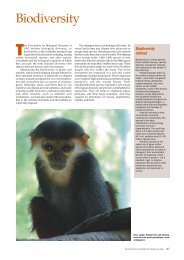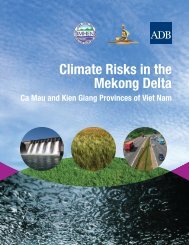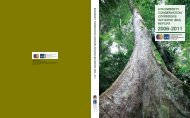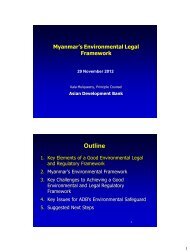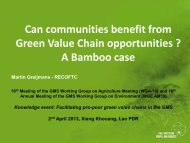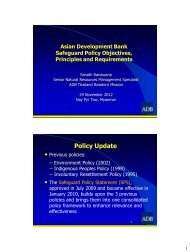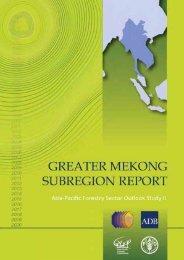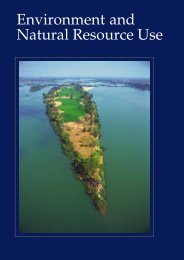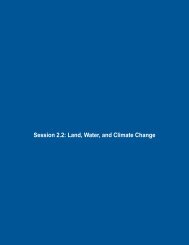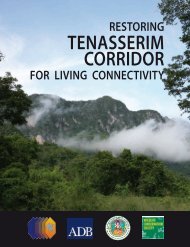What is a Carbon Neutral Transport Corridor? - Greater Mekong ...
What is a Carbon Neutral Transport Corridor? - Greater Mekong ...
What is a Carbon Neutral Transport Corridor? - Greater Mekong ...
Create successful ePaper yourself
Turn your PDF publications into a flip-book with our unique Google optimized e-Paper software.
<strong>Greater</strong> <strong>Mekong</strong> Subregion<br />
Core Environment Program and Biodiversity Conservation <strong>Corridor</strong>s Initiative<br />
<strong>Neutral</strong> <strong>Transport</strong> <strong>Corridor</strong> <strong>is</strong> proposed. Finally, some initiatives and policies are suggested as<br />
possible ways to develop a CNTC.<br />
1.2 <strong>Transport</strong> corridors and carbon em<strong>is</strong>sions in the GMS<br />
It <strong>is</strong> widely accepted that transport <strong>is</strong> one of the main drivers for the increase in greenhouse gas<br />
em<strong>is</strong>sions and a changing global climate. Globally, transport was responsible for 13% of<br />
greenhouse gas em<strong>is</strong>sions (GHGs) in 2006 4 . Across the GMS countries, average transport related<br />
GHGs have been seen to be lower than the global average 5 (see Figure 1). However, various<br />
forecasts of future trends show that within South and Southeast Asia transport related em<strong>is</strong>sions<br />
will see a three to five fold increase by 2030 (if no new policies are introduced to tackle these<br />
em<strong>is</strong>sions), making Asia responsible for 31% of global transport em<strong>is</strong>sions by 2030 6 . Th<strong>is</strong> increase<br />
in transport em<strong>is</strong>sions has been attributed mainly to increasing numbers of light duty vehicles<br />
(passenger cars and smaller road freight vehicles) and heavy goods vehicles (larger road freight<br />
vehicles).<br />
40.0<br />
35.0<br />
30.0<br />
25.0<br />
20.0<br />
15.0<br />
10.0<br />
5.0<br />
0.0<br />
GHGs from transport as a percentage of overall GHGs<br />
in 2001<br />
Viet Nam Myanmar Thailand China* GMS<br />
average<br />
Source: World Resources Institute, 2005<br />
*Th<strong>is</strong> <strong>is</strong> the total for the People’s Republic of China as a whole.<br />
Global<br />
average<br />
Figure 1: Greenhouse<br />
gas em<strong>is</strong>sions from the<br />
transportation sector in<br />
the GMS<br />
The initial focus of the economic corridors within the GMS program has been on improving road<br />
4 International Energy Agency, 2008. World Energy Outlook 2008. IEA: Par<strong>is</strong>.<br />
5 Th<strong>is</strong> figure <strong>is</strong> based on 1994 data and excludes Lao PDR and Myanmar due to a lack of d<strong>is</strong>aggregated GHG data (UNSTAT, 2009).<br />
6 Schipper, L., Fabian, H., and Leather, J., 2009. <strong>Transport</strong> and <strong>Carbon</strong> Dioxide Em<strong>is</strong>sions: Forecasts, Options Analys<strong>is</strong>, and<br />
Evaluation. ADB Sustainable Development Working Paper Series. ADB: Manila.<br />
Draft Concept Paper – <strong>What</strong> <strong>is</strong> a <strong>Carbon</strong> <strong>Neutral</strong> <strong>Transport</strong> <strong>Corridor</strong>?<br />
25 th November 2010<br />
Page 2





